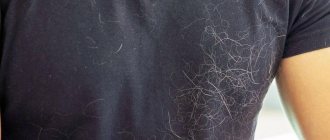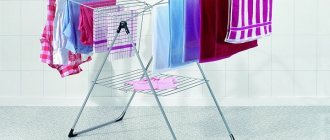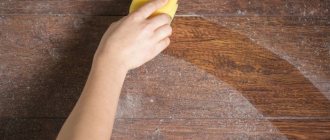All cat owners, especially long-haired breeds, are faced with the problem of cat hair. This is especially felt in autumn and spring, since during these periods seasonal molting occurs, and the handsome man’s fur ends up on carpets, clothes, and his favorite bedspread. There are different ways to help remove cat hair from your home.
Why does a cat have a lot of hair?
Shedding in cats is a seasonal phenomenon. Both house and yard mooses shed their fur in spring and autumn, but the first moults also shed in winter - during the heating season. The undercoat of cats also falls out significantly after childbirth due to hormonal changes in the body. This is normal, you will just have to wait out this period.
However, if your cat's hair is growing so bad that bald spots appear on his thick hair, you should immediately consult a veterinarian. This may indicate a vitamin deficiency or a serious illness.
Comfortable microclimate
If apartment owners love warmth, it is worth considering whether constantly high air temperatures are harmful to the health of their pets. Of course, there is no need to sacrifice your comfort and health and spend the winter wrapped in blankets. It is much more reasonable to use a system of compromises:
- ventilate the room more often;
- move the cat to the coolest room (rearrange its food bowls, toys and resting place there);
- turn on the air conditioning system in the apartment;
- If the air is too dry, turn on the humidifier.
My cat has a lot of hair coming out, what should I do?
Owners often wonder: what to do to prevent a cat from shedding? To minimize the scale of the disaster, make it a habit to stroke the fur once a day with a special mitten. Brush long-haired cats with brushes. In the summer, the animal can be taken to a groomer, who will give it an interesting haircut, for example, a la lion.
Interesting.
Cats use their own method of getting rid of excess fur - licking. Veterinarians recommend giving your pet a special paste to remove hair from the stomach, or offering to chew green grass.
How to brush cats' fur? It all depends on the breed. There is a misconception that it is better to comb Persians with slicker brushes. In fact, this tool is not suitable, since it severely injures the soft, literally airy fur of the cat. Pay attention to combs or brushes made of quality materials. Short-haired cats can be combed with a rubber mitten, British and Scottish cats can be combed with a furminator, which does an excellent job in the undercoat. Comb the Maine Coon's luxurious coat with combs.
Take care of the proper nutrition of the animals - feed them exclusively high-quality dry or wet food, and best of all, holistic food. Consider switching to the BARF feeding system, which is based on feeding animals fresh meat, vegetables and fruits. This will maintain the balance of vitamins and minerals and keep your pet healthy.
Wall-mounted corner cat brushes are another way to reduce the amount of lint in your apartment. They are fixed on the protruding corners and treated with catnip. The cat will appreciate such a device and will be happy to rub its whole body against it. Murka - pleasure, less hassle for you!
Most cats do not like to bathe, but once every six months you can organize a bath day and wash the animal with shampoo. Choose a detergent based on your coat type and length. Complete the procedure with conditioner, which will help reduce static and smooth hairs.
Preventive measures to help reduce shedding
There are several measures that can reduce hair loss. Remember that every hair you remove from your pet is less hair that needs to be removed.
One simple way to reduce shedding is to brush your dog every day. The procedure should not be very long. A few minutes of brushing will help get rid of a lot of loose fur.
Regular washing also helps reduce shedding. There is no magic shampoo that works better than others. Just the physical action of water removes a lot of hair. Feeding high quality food reduces excessive loss. And of course, remember about parasites in animals that can cause hair loss. Give your pet health and safe removal of worms with the help of a natural complex.
How to deal with cat hair in an apartment
What to do if a cat sheds and how to remove hair from the floor, furniture and clothes? We will share with you universal methods of dealing with fluff in the house.
How to remove wool from the floor
The main assistant of any cat owner is a vacuum cleaner. Ideally, of course, a robot vacuum cleaner that will do all the work on its own while you enjoy a cup of aromatic tea. A regular vacuum cleaner does just as well, but requires your participation.
Wet cleaning should ideally be done daily, but rubbing with a cloth or waving a mop is very labor-intensive, and a home cleaner equipped with a surface-washing function will help you with this. However, a wet cloth perfectly collects hairs that a vacuum cleaner couldn’t handle. There are also special mops on sale with a rubber coating in the form of a roller that attracts hairs.
How to get rid of wool on a carpet
A turbo brush is the best way to remove wool from carpets. It wraps hairs and makes cleaning much easier. You can also use a stiff brush, but few people like crawling on the carpet on all fours.
How to clean furniture
Use a vacuum cleaner to clean furniture. Brush from top to bottom, first vacuum the shelves, then the fronts of the cabinets, then work on the window sills and only then move on to the beds and sofas.
There is an old but proven method for removing cat hair from upholstery: wet a sheet, cover the chair or sofa and tap it firmly with a beater.
How to remove cat hair from clothes and textiles
How to get rid of wool on clothes? It sticks to all fabrics and glitters treacherously on the street, revealing you as the owner of the cat. Hairs are especially noticeable on dark things.
The easiest way to remove hairs is with a wet palm. Run your hand over the clothing from top to bottom, rolling the wool into balls.
Use sticky rollers to clean things, choose reusable solid gel rollers to save your family budget. They can be washed with water.
To reduce static, wash clothes with conditioner or treat them with an antistatic agent. Keep closets closed and clothes hidden in covers.
Removable covers
The house in which the pet lives has a special note: fur hairs covering the paths, carpets, sofa and armchairs. When a cat sheds, its fur floats in the air and lands on every surface in its path.
Some practical owners use special covers and blankets for furniture to keep the house clean. They cover sofas and beds in the place where the pet likes to perch. The fabric is cleaned of wool in the washing machine weekly, which helps keep the house and upholstered furniture clean.
Cats are big fans of sheltering in a soft place. A separate pillow or sheet folded several times is prepared for them so that the animal does not spread its fur in other parts of the apartment. Observant owners provide removable and comfortable sun loungers, which are changed or cleaned when dirty. This technique ensures the cleanliness of the apartment from annoying falling hair.
Clean home owners carefully monitor the cleanliness of the coating and resort to washing whenever required.
How to use cat hair
Does cat fur have any uses? Of course, you don’t have to throw it away, but put it to use. The hair has a gorgeous shine and a silky structure. From wool you can make a blanket, mattress cover, blanket, sciatica belt, and use fluff for wet and dry felting.
The dry felting method is used to create three-dimensional products. The fibers are tightly connected and form felt. Wet felting is ideal for creating small toys or decorations.
In Switzerland, cat hair has long been used to treat osteochondrosis. Their fluff is used to make belts and socks to increase blood circulation and relieve joint pain.
Some craftsmen make expensive jewelry and designer bags from wool.
Silicone roller
The silicone roller is quite practical because it is reusable, you just need to wet it, it will become viscous and pick up all the hair and dirt from any area. There are many sizes and prices, with a long detachable handle, up to the size of a foldable bag, so you can always carry it with you. You can buy them in cleaning stores, supermarkets... the price depends on the quality, the cheaper it is, the faster the silicone wears out and the less it will last. This is definitely a good cleaning method and is more environmentally friendly than rollers or tape.
Tips and tricks for pet owners
We have collected tips for caring for cats that will make your life easier:
- Provide your pet with a place to sleep, eat, and go to the toilet. Buy bowls for water and food, as well as a mat for them, as some cats eat sloppily, spilling water and scattering food on the floor. Place the house and scratching post in the corner of the room.
- Bathe your cat once every 3-6 months if she does not go outside for walks. If your pet is free-range, you will have to bathe it more often, because dust, dirt, and dry grass stick to its coat. The optimal water temperature is 38-38.5°C. Long-haired cats can be blow-dried on low setting.
- Brush short-haired cats once a week, or several times during the shedding period. Brush long-haired cats daily and trim mats if necessary. Remember, the softer the fur, the softer the brush, and vice versa.
- Trim the nails once every 2 weeks with a nail clipper, being careful not to catch a blood vessel.
- Clean your eyes and nose daily with a damp cloth or swab. If purulent discharge appears, contact your veterinarian.
- Clean your ears with a special lotion once a week. Earwax should be light in color and without an unpleasant odor; if it is darkened and smells bad, take your pet to the veterinary clinic.
- If there is no solid food in the diet, the cat needs to brush its teeth from plaque and tartar once a week with toothpaste for cats.
- Once every three months, it is necessary to show the animal to a veterinarian and promptly vaccinate. A specialist will examine your pet and be able to identify serious diseases in time. 10 days before vaccination, treat for worms.
Bathing
Frequent bathing unless necessary is unacceptable. Each cat’s “bath regime” is special, depending on many factors. But with intense shedding, it is recommended to wash the cat. Bathing will speed up the loss of old fur and free the skin from dirt. It is important to use special shampoos that do not irritate or dry out the animal’s skin. When selecting products, it is recommended to consult a veterinarian. So, for bathing kittens and adult cats, you can use “Gentle” shampoo, containing the natural component of aloe vera. It foams well, gently cleanses the coat and gives it shine.
Sticky Helpers
Cat hair annoyingly settles on clothes, beds, and soft seats. You can remove its remnants with lint rollers. This device is inexpensive and quite easy to use. Its disadvantage is that it is quick to use. The rollers run out quickly and their number may not be enough to clean a large area. In this case, wide tape or a roll of self-adhesive paper can be successfully used. The adhesive tape is torn off the roll and placed against areas where wool accumulates: fabric areas or furniture. The tape will easily collect hairs, even those that are invisible at first glance, and will do its job just as well as a vacuum device.
A clean animal means a clean home
During periods of heavy shedding, owners are concerned about the problem of how to deal with cat hair in the apartment. With timely intervention, it will not be difficult for a careful owner to keep the cat clean.
First you need to clean your cat's fur. The animal is washed twice with shampoo and conditioner. Rinse with water at least twice to completely remove excess hair. Don’t forget about your pet’s health and cover its ears while bathing. Drops of water can harm a cat's ears.
Sources:
https://gafki.ru/koshki/kak-izbavitsa-ot-sersti.html https://kotikoshka.com/ukhod-za-koshkami/kak-izbavitsya-ot-shersti-koshki-v-kvartire-poleznye-rekomendatsii .html https://koshek.ru/kak-borotsya-s-vyipadayushhej-sherstyu-koshek-v-kvartire.html











